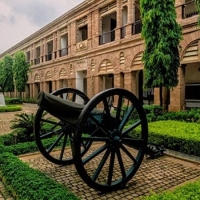The Scindia School in Gwalior, Madhya Pradesh Admission, Fees Structure

Where is The Scindia School ?
The Scindia School is Located in Gwalior , Madhya Pradesh, India
Address of The Scindia School, Gwalior
THE FORT,
GWALIOR - 474008
MADHYA PRADESH, INDIA
+91-7512480750
office@scindia.edu
principal@scindia.edu
How do I contact The Scindia School?
Call at +91-7512480750 to contact The Scindia School
About The Scindia School
The Scindia School, with its unique location, is a notably different residential school. Located atop the magnificent Gwalior Fort it has the city below and the hills across. The ramparts of the Fort have witnessed Tantia Tope’s troops battle the British, and seen the Rani of Jhansi breathe her last in her final assault. A casual glance out of a classroom window may well find eyes rest on an exquisite sixth century temple, adorned with bas-reliefs.The history of The Scindia School provides a fascinating peep into the unfolding history of India, intertwined with the making of modern India. The Scindia School, originally The Sardars’ School, was founded in 1897 by the visionary HH Maharaja Madhavrao Scindia I. The turn of the nineteenth century was a period of turmoil and disorientation, as the colonial Macaulayite system of education with English as the medium of instruction, was displacing the traditional pathshalas, madarsas and gurukuls. Even back then, the school captured the best of the learning of the new world, and combined it with the best of timeless India. Indeed ever since, The Scindia School has unfailingly been one step ahead of its time.The Scindia School, with its unique location, is a notably different residential school. Located atop the magnificent Gwalior Fort it has the city below and the hills across. The ramparts of the Fort have witnessed Tantia Tope’s troops battle the British, and seen the Rani of Jhansi breathe her last in her final assault. A casual glance out of a classroom window may well find eyes rest on an exquisite sixth century temple, adorned with bas-reliefs.
Besides being the administrative headquarters of Gwalior district and Gwalior division, Gwalior has many administrative offices of the Chambal division of northern Madhya Pradesh Several administrative and judicial organisations, commissions and boards have their state and national headquarters situated in the city Gwalior was the winter capital of the state of Madhya Bharat which later became a part of the larger state of Madhya Pradesh Prior to Indian independence on 15 August 1947, Gwalior remained a princely state of the British Raj with the Scindia as the local rulers High rocky hills surround the city from all sides, on the north it just forms the border of the Ganga- Yamuna Drainage Basin.
The city however is situated in the valley between the hills Gwalior's metropolitan area includes Gwalior city centre, Morar Cantonment, Lashkar Gwalior (Lashkar Subcity), Maharaj Bada, Phool Bagh, ThatipurGwalior was one of the major sites of rebellion during the 1857 uprising Post-independence, Gwalior has emerged as an important tourist attraction in central India while many industries and administrative offices came up within the city Before the end of the 20th century it became a million plus agglomeration and now it is a metropolitan city in central India.
Gwalior is surrounded by industrial and commercial zones of neighbouring districts (Malanpur – Bhind, Banmore – Morena) on all three main directions A 2016 report of the World Health Organization found Gwalior to be the second-most air-polluted city in the world and the most polluted city in IndiaGwalior has been selected as one of the hundred Indian cities to be developed as a smart city under PM Narendra Modi's flagship Smart Cities Mission
Subsequently, the region was ruled by the major dynasties of India The Maratha empire dominated the majority of the 18th century After the Anglo Maratha Wars 19th century, the region was divided into several princely states under the British and incorporated into Central Provinces and Berar and the Central India Agency After India's independence, Madhya Pradesh state was created with Nagpur as its capital: this state included the southern parts of the present-day Madhya Pradesh and northeastern portion of today's Maharashtra In 1956, this state was reorganised and its parts were combined with the states of Madhya Bharat, Vindhya Pradesh and Bhopal to form the new Madhya Pradesh state, the Marathi-speaking Vidarbha region was removed and merged with the Bombay State.
This state was the largest in India by area until 2000, when its southeastern Chhattisgarh region was designated a separate state The economy of Madhya Pradesh is the tenth-largest state economy in India with ₹809 lakh crore (US$110 billion) in gross domestic product and a per capita GDP of ₹90,000 (US$1,300) Madhya Pradesh ranks 32nd among Indian states in human development index Rich in mineral resources, Madhya Pradesh has the largest reserves of diamond and copper in India.
More than 30% of its area is under forest cover Its tourism industry has seen considerable growth, with the state topping the National Tourism Awards in 2010–11 In recent years, the state's GDP growth has been above the national average